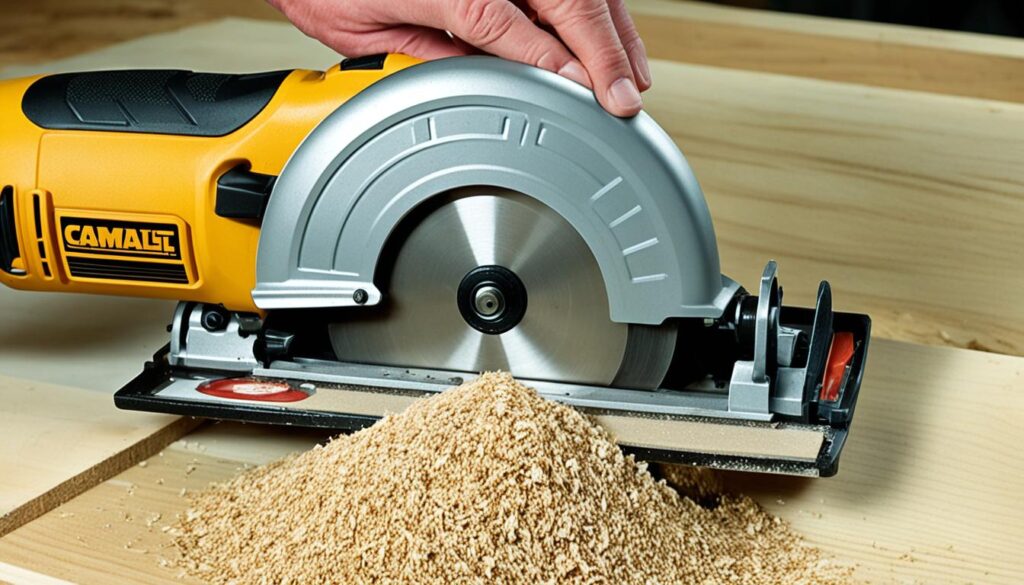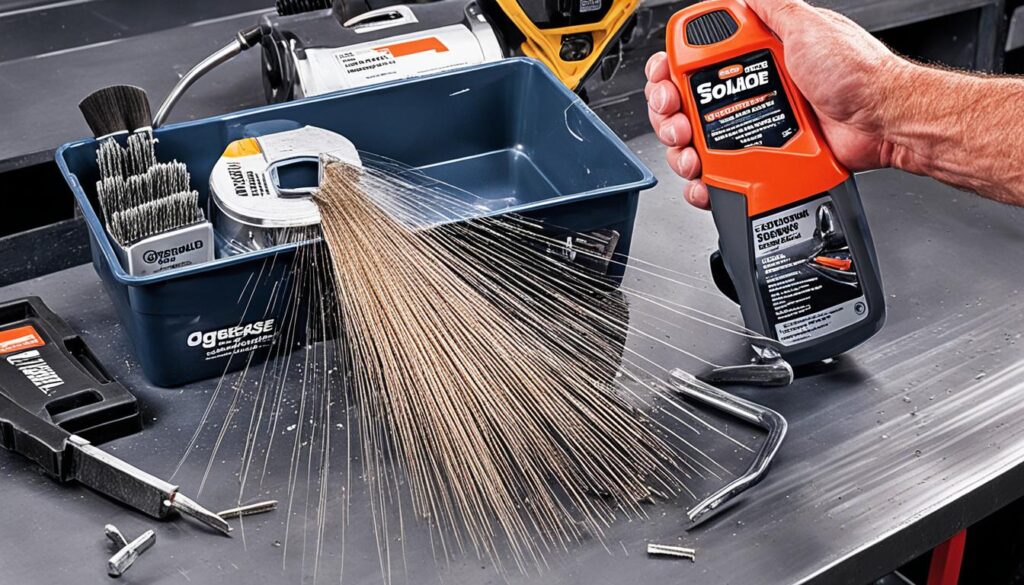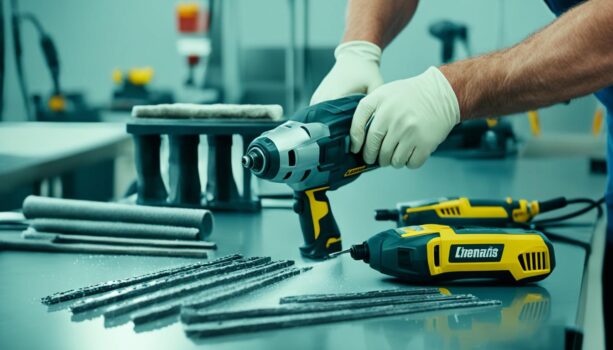Have you ever wondered if there’s a better way to clean your hand tools and power tools? Are you tired of seeing dirt and grime build up on your trusty tools, affecting their performance and lifespan?
In this comprehensive guide, we will unveil the best ways to clean hand and power tools effectively. Say goodbye to rusty tools and hello to tools that shine and perform like new. Get ready to discover the most effective tool-cleaning methods and tool-cleaning techniques that will revolutionize the way you maintain your tools.
Are you ready to take your tool cleaning game to the next level? Let’s dive in!
Disclaimer:
Our recommendations are based on extensive experience with and/or knowledge of these products, and we do so not because of the modest commissions we could earn but rather because we believe they are actually beneficial and useful. We are honored to be these tools' affiliates. We might receive commissions from Amazon, and other merchants when you buy something after clicking one of our links. Our affiliate policy is covered in more detail here. If you don't think these things will help you accomplish your goals, please don't spend any money on them.
Key Takeaways
- Regular cleaning is essential to ensure the longevity and optimal performance of hand and power tools.
- The best ways to clean hand tools and power tools involve using appropriate cleaning methods and techniques.
- Proper tool cleaning prevents rust and corrosion, extending the lifespan of your tools.
- By following the step-by-step instructions and expert tips in this guide, you can keep your tools in pristine condition.
- Cleaning your tools regularly saves you money in the long run by avoiding costly replacements.
Understanding the Importance of Tool Hygiene
Maintaining tool hygiene goes beyond just aesthetics. Regular cleaning of your tools offers numerous benefits in the long run. It ensures that your tools operate at peak performance, reduces the risk of accidents caused by faulty equipment, and prolongs the overall lifespan of the tools. Additionally, proper cleaning and maintenance help prevent rust and corrosion, which can deteriorate tools over time.
The Long-Term Benefits of Regular Tool Cleaning
Regularly cleaning your tools not only removes dirt and debris but also prevents the buildup of grime that can affect their functionality. By keeping your tools clean, you can ensure that they perform optimally and with precision, allowing you to work efficiently and achieve professional-quality results. Moreover, regular cleaning helps to extend the lifespan of your tools, saving you money by reducing the need for frequent replacements.
Preventing Rust and Corrosion for Tool Longevity
Rust and corrosion are common enemies of tools, especially those made of metal. When tools are exposed to moisture or stored in damp environments, they become susceptible to rust and corrosion. Regular cleaning and maintenance play a crucial role in preventing these detrimental effects. By removing moisture and applying protective coatings, you can safeguard your tools from rust and corrosion, ensuring their longevity and reliable performance for years to come.
What should you use to clean hand and power tools?
When it comes to cleaning hand and power tools, using the right cleaning products is crucial. Different types of tools may require specific cleaning solutions and materials to ensure effective cleaning without causing any damage. Let’s explore the various options available for cleaning hand and power tools, including recommended cleaning solutions, hand tool cleaners, power tool cleaning products, and other necessary materials.
Hand tool cleaners are specially formulated to remove dirt, grease, and grime from hand tools without damaging their surfaces. They are typically available in spray or liquid form, allowing for easy application and thorough cleaning. These cleaners are designed to dissolve tough stains, rust, and corrosion, while also providing protection against future damage.
When it comes to power tools, there are cleaning products specifically designed for their unique requirements. Power tool cleaning products are formulated to remove dust, debris, and other contaminants that can accumulate on the tool surfaces and affect their performance. These products often come in aerosol or spray form, making it easy to reach tight spaces and crevices.
In addition to specialized cleaners, there are general tool-cleaning solutions that can be used for both hand and power tools. These solutions are typically made from mild detergents or degreasers, which effectively remove dirt and grime without causing any harm to the tool surfaces. They are versatile and can be used on various types of tools.
When choosing the best cleaners for your hand and power tools, it is important to consider factors such as the type of tool, the material it is made of, and the level of dirt or grime buildup. Some tools may require gentler cleaners, while others may need more powerful degreasers. Always read the instructions on the cleaning product and follow the manufacturer’s recommendations for safe and effective use.
| Cleaning Product | Recommended Use |
|---|---|
| Hand Tool Cleaner | For removing dirt, grease, and rust from hand tools. |
| Power Tool Cleaning Product | For cleaning the surfaces of power tools and removing dust and debris. |
| General Tool Cleaning Solution | For versatile cleaning of both hand and power tools. |
While cleaning tools, it is essential to wear protective gloves to avoid any contact with cleaning chemicals and to prevent injuries. Additionally, always ensure that the tools are unplugged and turned off before cleaning.
By using the right cleaning products, you can effectively maintain the cleanliness and performance of your hand and power tools, ensuring that they last longer and continue to serve you well.
Key Steps for Cleaning Hand Tools
Cleaning hand tools is an essential part of maintaining their performance and durability. By regularly cleaning your hand tools, you can remove dirt and debris, prevent rust and corrosion, and ensure their longevity. In this section, we will provide a detailed step-by-step guide on how to clean hand tools effectively.
Gathering Essential Cleaning Materials
Before you begin cleaning your hand tools, it is important to gather the necessary cleaning materials. Here are the essential items you will need:
- Warm water
- Mild dish soap
- A toothbrush or wire brush
- Clean, lint-free cloths
- Rust remover or vinegar (for stubborn rust)
- Corrosion protectant spray or oil
Having these materials readily available will make the cleaning process more efficient and effective.
Detailed Process of Cleaning Hand Tools
Now that you have gathered your cleaning materials, follow these steps to clean your hand tools:
- Start by removing any excess dirt or debris from the tools. Use a toothbrush or wire brush to scrub away stubborn grime.
- Fill a bucket or sink with warm water and add a few drops of mild dish soap.
- Submerge the tools in soapy water and use a cloth or brush to scrub the surfaces. Pay attention to hard-to-reach areas and crevices.
- Rinse the tools thoroughly with clean water to remove any soap residue.
- Dry the tools completely using a clean, lint-free cloth. Ensure there is no moisture left on the tools, as it can lead to rust formation.
- If you encounter stubborn rust, apply rust remover or vinegar to the affected areas and scrub gently. Rinse and dry the tools again.
Applying Corrosion Protectors After Cleaning
After thoroughly cleaning your hand tools, it is crucial to apply a corrosion protectant to prevent rust and corrosion. Here’s how:
- Choose a corrosion protectant spray or oil specifically designed for hand tools.
- Apply a thin layer of the protectant to the surfaces of the cleaned tools.
- Allow the protectant to dry according to the manufacturer’s instructions.
By taking this extra step, you can ensure the long-term durability of your hand tools and protect them from the effects of moisture and corrosion.
Cleaning Techniques for Power Tools
Proper cleaning techniques are essential for maintaining the performance and longevity of your power tools. In this section, we will explore various methods to clean your power tools effectively, ensuring their optimal functionality.
1. Cleaning the Exteriors:
To start, it is crucial to clean the exteriors of your power tools regularly. Use a soft cloth or a brush to remove any dust, dirt, or debris that may have accumulated on the surfaces. Pay special attention to vents and crevices where dust tends to build up.
2. Removing Dust and Debris:
Dust and debris can hinder the performance of your power tools. Use a vacuum cleaner or a compressed air canister to blow away the dust from hard-to-reach areas. Be cautious when using compressed air to prevent any damage to delicate components.
3. Cleaning Tool Attachments:
Power tool attachments, such as blades and bits, also require regular cleaning. Remove the attachments and wipe them clean with a cloth or a brush. For stubborn residue, you can soak the attachments in a mild cleaning solution and then scrub gently.
4. Lubricating Moving Parts:
Maintaining proper lubrication is crucial for the smooth operation of power tools. Regularly check the moving parts, such as gears and joints, and apply a small amount of lubricant to ensure their optimal performance. Refer to the manufacturer’s guidelines for the recommended lubricants.
5. Storing Power Tools:
When not in use, it is important to store your power tools properly. Keep them in a clean, dry environment to prevent dust accumulation and moisture damage. Use protective cases or storage boxes to safeguard them from external elements.
Remember to always follow the manufacturer’s instructions for cleaning and maintaining your specific power tools. By adopting these cleaning techniques, you can extend the lifespan of your power tools and ensure their reliable performance for years to come.

Optimal Methods for Cleaning Drill Bits and Saw Blades
Drill bits and saw blades are critical cutting tools that require regular cleaning to maintain their sharpness and efficiency. In this section, we will explore the optimal methods for cleaning drill bits and saw blades to ensure their longevity and peak performance.
Choosing the Right Cleaning Solutions
When it comes to cleaning drill bits and saw blades, selecting the appropriate cleaning solutions is crucial. The cleaning solution should effectively remove debris, lubricate the cutting surfaces, and prevent rust formation. Here are some factors to consider when choosing a cleaning solution:
- Compatibility: Ensure that the cleaning solution is suitable for the material of your drill bits and saw blades. Different materials require different cleaning solutions to avoid damage.
- Effectiveness: Look for a cleaning solution that effectively removes built-up residue, such as sawdust, sap, or metal shavings from the cutting edges.
- Rust Prevention: Consider a cleaning solution that offers rust-prevention properties to protect your drill bits and saw blades from corrosion.
Take the time to research and select the right cleaning solutions that meet your specific needs for cleaning drill bits and saw blades.
Step-by-Step Guide to Cleaning Cutting Accessories
Proper cleaning techniques are essential to ensure the optimal performance and longevity of drill bits and saw blades. Follow these step-by-step instructions to clean your cutting accessories effectively:
- Start by removing the drill bit or saw blade from its respective tool. Use caution and follow the manufacturer’s instructions for safe removal.
- Inspect the cutting edges for any signs of damage, such as chips or dullness. If necessary, sharpen or replace the cutting accessory.
- Prepare a cleaning solution suitable for the material of your drill bit or saw blade. Dilute the solution as instructed by the manufacturer.
- Submerge the cutting accessory in the cleaning solution and allow it to soak for the recommended duration. This will help to loosen any built-up debris or residue.
- Use a soft-bristle brush or toothbrush to gently scrub the cutting edges and surfaces of the drill bit or saw blade. Pay close attention to remove any stubborn debris or residue.
- Rinse the cutting accessory thoroughly with clean water to remove the cleaning solution and debris.
- Pat dry with a clean cloth or allow the cutting accessory to air-dry completely.
- Inspect the cleaned drill bit or saw blade for any remaining debris or signs of damage. If necessary, repeat the cleaning process.
- Apply a thin coat of lubricant or rust preventer to the cutting edges and surfaces of the drill bit or saw blade to protect it from corrosion.
By following these step-by-step instructions, you can maintain the cutting efficiency and lifespan of your drill bits and saw blades.
Tips to Remove Grease and Prevent Rust Formation
When it comes to tool maintenance, two common challenges that require attention are grease accumulation and rust formation. In this section, we will provide valuable tips and techniques to help you effectively remove grease from your tools and prevent rust formation, extending their lifespan and ensuring their optimal performance.
Effective Grease Removal Techniques
Grease can build up on tools over time, hindering their functionality and attracting dirt and debris. Here are some effective techniques to remove grease:
- Use a degreasing cleaner: Choose a suitable degreasing cleaner specifically designed for removing grease from tools. Apply the cleaner following the manufacturer’s instructions, and use a brush or cloth to scrub away the grease.
- Soak in hot, soapy water: For tools with grease that is not too stubborn, soaking them in hot, soapy water can help loosen the grease. Use a brush or sponge to scrub away the loosened grease.
- Use citrus-based cleaners: Citrus-based cleaners are highly effective in cutting through grease. Apply the cleaner to the greasy areas, let it sit for a few minutes, and then wipe away the grease using a cloth or sponge.
- Utilize a power washer: If you have access to a power washer, it can be an efficient way to remove grease from tools. The high-pressure water stream can dislodge the grease, leaving your tools clean and ready to use.
Remember to always wear appropriate protective gear, such as gloves and safety goggles, when using cleaning products and power tools.
Rust Removal and Defense Strategies
Rust can significantly damage tools and affect their functionality. Here are some effective rust removal methods and defense strategies:
- Use a rust remover: There are various rust removers available in the market that can dissolve and remove rust from tools. Apply the rust remover to the affected areas, let it sit for the recommended time, and then scrub away the rust using a wire brush or abrasive pad.
- Use vinegar or lemon juice: For light rust, you can try using natural acids like vinegar or lemon juice. Soak the rusted parts in the vinegar or lemon juice for a few hours or overnight, scrub away the rust, and rinse with water.
- Preventive measures: To defend against rust formation, it’s important to keep your tools dry and protected. After cleaning, ensure that your tools are thoroughly dried before storage. Apply a thin layer of protective oil or lubricant to metal surfaces to create a barrier against moisture.
- Store in a dry environment: Moisture promotes rust formation, so it’s crucial to store your tools in a dry, well-ventilated environment. Consider using moisture-absorbing materials, such as silica gel packets or desiccant packs, in your tool storage area to help keep the moisture level low.

By following these tips to remove grease effectively and implement defense strategies against rust, you can maintain your tools in optimal condition, ensuring their longevity and reliable performance.
Conclusion
Proper cleaning and maintenance are essential for safeguarding the functionality and longevity of your tools. By regularly cleaning your hand and power tools and establishing a cleaning routine, you can ensure their optimal condition and enhance their performance throughout their lifespan.
Cleaning tools not only removes dirt and debris but also prevents rust and corrosion, saving you money in the long run. Regular maintenance extends the lifespan of your tools and reduces the risk of accidents caused by faulty equipment.
To maintain your tools effectively, follow the best practices outlined in this guide. Make sure to gather the necessary cleaning materials, including appropriate cleaning solutions and degreasers, and thoroughly clean your hand tools using a step-by-step process. Don’t forget to apply corrosion protectors after cleaning to ensure long-term durability.
For power tools, use specific cleaning techniques to clean the exteriors, remove dust, and maintain their overall performance. Additionally, pay attention to cleaning drill bits and saw blades as they require special care. Choose the right cleaning solutions and follow the provided step-by-step guide to keep these cutting accessories sharp and efficient.
In conclusion, prioritize the maintenance of your tools by establishing a regular cleaning routine. By doing so, you will safeguard their functionality, prevent rust formation, and prolong their lifespan. Remember, a well-maintained tool not only works better but also keeps you safe during your projects.



